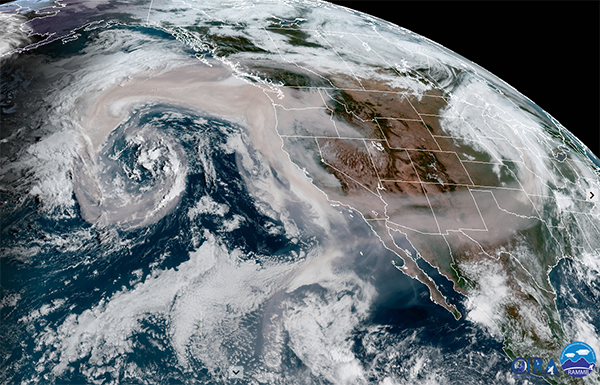A .gov website belongs to an official government organization in the United States.
A lock () or https:// means you've safely connected to the .gov website. Share sensitive information only on official, secure websites.
7 September 2021
adapted from the story by CIRES Communications
The first-ever WMO Air Quality And Climate Bulletin highlights connections between air quality and climate change.
Human-caused emissions of air pollutants fell during last year's COVID-19 economic slowdowns, improving air quality in some parts of the world, while wildfires and sand and dust storms in 2020 worsened air quality in other places, according to a new report from the World Meteorological Organization (WMO). Two Cooperative Institute for Research in Environmental Sciences (CIRES) at the University of Colorado Boulder scientists working at the NOAA laboratories contributed to the WMO's first-ever Air Quality and Climate Bulletin, released on September 3.
The bulletin highlights the connections between air quality and climate change, including how persistent weather patterns amplified 2020 wildfire conditions, leading to increased regional-scale particulate matter pollution; the impact of COVID-19 travel restrictions on air quality worldwide; and estimates of human mortality due to long-term exposure to ozone and particulate matter pollution. The launch of the report coincides with the United Nations International Day of Clean Air for Blue Skies.
Owen Cooper with NOAA CSL is lead editor of the first edition of the WMO Air Quality and Climate Bulletin, and Irina Petropavlovskikh with NOAA Global Monitoring Laboratory (GML) is a co-author. NOAA also provided long-term ozone monitoring data from atmospheric baseline observatories in Barrow, Alaska; Mauna Loa, Hawaii; and South Pole, Antarctica.
"Climate change, caused by the accumulation of greenhouse gases in the atmosphere, is happening on a decades-long timescale and is driving environmental changes worldwide. The impacts of air pollutants including ozone and particulate matter occur near the surface, on timescales of days to weeks and across spatial scales ranging from local to regional. Despite these differences, air quality and climate change are strongly interconnected," the report's authors stated. For example, human activities that release long-lived greenhouse gases into the atmosphere can also increase concentrations of shorter-lived ozone and particulate matter in the atmosphere.

According to the new report, the 2020 wildfire season was marked by extreme fires in Siberia and the western United States, exacerbated by persistent weather patterns that produced hot and dry conditions, including a historic high-latitude heatwave in Siberia. Fires in the United States contributed to unhealthy levels of air pollution affecting 20–50 million people in the U.S. West and in regions downwind of the fires.
By contrast, COVID-19 pandemic triggered worldwide travel restrictions that reduced emissions of many air pollutants in 2020, although impacts on ground and atmospheric levels of ozone, particulate matter, and other pollution varied widely. The report concluded that average PM2.5 concentrations decreased by 30 to 40 percent during the most stringent restrictions in 2020 compared with the same periods in 2015-2019, although PM2.5 increased in some places because of long-range transport of African dust and/or biomass burning.
Changes in ozone concentrations also varied greatly across urban areas, ranging from no overall change to small increases, as was the case for Europe, and larger increases in East Asia and South America. The report notes that the ozone response is complicated, with preliminary results showing unusual ozone decreases of 10 to 15 percent in rural regions of Europe during summer.
The bulletin also summarizes the latest estimates, from the 2019 Global Burden of Disease report published in The Lancet, of human mortality due to long-term exposure to outdoor ozone and particulate matter pollution. According to that assessment, global mortality increased from 2.3 million in 1990 (91% due to particulate matter, 9% due to ozone) to 4.5 million in 2019 (92% due to particulate matter, 8% due to ozone).
WMO will issue this report annually, with updates on the state of air quality and its connections to climate change.